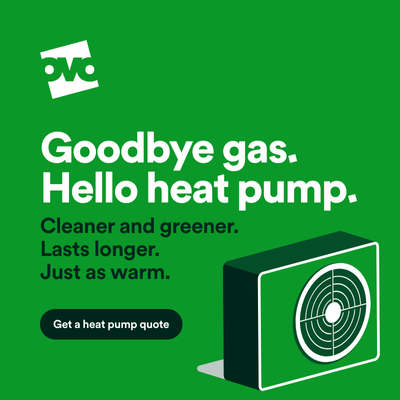Ecodan cycling
Posted by: @derek-mI have attached a radiator output calculator in a spreadsheet. The yellow highlighted cells are the ones that can be varied.
If you know the flow and return temperatures then put those in the LWT and RWT cells, set the indoor temperature, and the answer will appear in the left-hand side table.
If you know the required thermal energy output, put that in the Heat Output cell in the right-hand table, the cell next to it gives the required average water temperature at the heat emitters. Half the Delta T needs to be added to this value to obtain the required LWT from the heat pump.
Thanks Derek, very useful.
I'm using the remote stat to turn the heating off at set temp +1 degree (at milder ambient temps). Set temp is 18C, so reaches 19C (the lounge is well insulated so runs a couple of degrees higher) - as the lounge runs at a different delta, I punched in the numbers for each rad separately to get an accurate number as possible. With IAT of 18C the total is 2638 watts, at 19C it's 2424 watts.
The 2424 number is still around 40% nominal pump capacity - I seem to recall 30-35% for capacity being accepted as what the Ecodan can modulate down to. H'mm.
Posted by: @gotaashpPosted by: @derek-mI have attached a radiator output calculator in a spreadsheet. The yellow highlighted cells are the ones that can be varied.
If you know the flow and return temperatures then put those in the LWT and RWT cells, set the indoor temperature, and the answer will appear in the left-hand side table.
If you know the required thermal energy output, put that in the Heat Output cell in the right-hand table, the cell next to it gives the required average water temperature at the heat emitters. Half the Delta T needs to be added to this value to obtain the required LWT from the heat pump.
Thanks Derek, very useful.
I'm using the remote stat to turn the heating off at set temp +1 degree (at milder ambient temps). Set temp is 18C, so reaches 19C (the lounge is well insulated so runs a couple of degrees higher) - as the lounge runs at a different delta, I punched in the numbers for each rad separately to get an accurate number as possible. With IAT of 18C the total is 2638 watts, at 19C it's 2424 watts.
The 2424 number is still around 40% nominal pump capacity - I seem to recall 30-35% for capacity being accepted as what the Ecodan can modulate down to. H'mm.
The values you calculated are the quantity of thermal energy that the heat emitters can supply to the rooms. To keep the IAT reasonably constant, it is necessary to balance the supply to the demand (heat loss).
Your heat loss calculation should have been made for an IAT of 21C and an OAT in the region of -2C or -3C. If it was made at say -3C, then the heat loss at an OAT of 9C should be in the region of 2.85kW at an IAT of 21C. At an IAT of 19C the heat loss would reduce to 2.375W, and at an IAT of 18C the heat loss would only be 2.138kW. To match the heat loss of 2.138kW at an IAT of 18C, would required a LWT of 33.7C and a RWT of 28.7C, which may be below the minimum output that the heat pump can supply.
Cycling is likely to occur when the heating demand (heat loss) is lower than the minimum continuous output of your heat pump, so as can be seen above, lowering the desired IAT will probably make cycling more likely.
What is the Delta T between LWT and RWT? What is the pump speed and flow rate?
Posted by: @walkers-heatpump
Not a bad call. I think my issue sometimes is not leaving it alone to do the learning! The urge to tweak is too great! In reference to my messages earlier in the year and your responses at the time - I think I also sometimes expect too much when returning from setback - I should be accepting slightly higher flow temps for that than I have been or accept slower warm up times if I tame it. Frustration often though has been it not going into steady state, it seemed to need to be about 4° outside for that to happen.
Now in my second year with our Ecodan 11.2 I'm trying to change my approach to looking less often at how it is running. After an initial feeling of alarm at the energy consumption in the coldest winter days, being able to look at the average monthly energy cost for a year has been reassuring.
Last year I collected data daily (max and min outside temperature, power consumed and delivered and overall COP). This year I'll look at things weekly (apart from max/min temperature because I think that the average temperature will provide a way to ensure that I can compare operating performance in broadly similar circumstances).
Things worth bearing in mind:
- the Ecodan lies about how much energy it consumes. We are lucky to have a freestanding energy consumption meter which has shown the actual consumption is almost always materially lower. This is only any use to calculate the overall COP because the Ecodan's own figures aren't a reliable way to apportion the actual consumption between water and heating (it spent all summer claiming to have consumed energy on heating when it was switched off).
- I'm running on weather compensation. (A downside of an otherwise very satisfactory installation is that the system doesn't know the temperature in the house because it uses third party controllers and the control panel is in the airing cupboard!) Late last winter I discovered how to tinker with the compensation curve and put a dog-leg into it which 'seems' to have improved efficiency- but its probably too early to say. I'm planning to look at cycling performance in hourly blocks during the day, based on outside temperature and amount of cycling. (In the coldest month last winter when the system was working hard our COP was significantly better than at other times.)
- I'm not going to obsess about COP because I'm not yet confident that running the system continually with a high COP will consume less energy than running it intermittently with a lower one.
Good luck!
Posted by: @derek-mThe values you calculated are the quantity of thermal energy that the heat emitters can supply to the rooms. To keep the IAT reasonably constant, it is necessary to balance the supply to the demand (heat loss).
Your heat loss calculation should have been made for an IAT of 21C and an OAT in the region of -2C or -3C. If it was made at say -3C, then the heat loss at an OAT of 9C should be in the region of 2.85kW at an IAT of 21C. At an IAT of 19C the heat loss would reduce to 2.375W, and at an IAT of 18C the heat loss would only be 2.138kW. To match the heat loss of 2.138kW at an IAT of 18C, would required a LWT of 33.7C and a RWT of 28.7C, which may be below the minimum output that the heat pump can supply.
Cycling is likely to occur when the heating demand (heat loss) is lower than the minimum continuous output of your heat pump, so as can be seen above, lowering the desired IAT will probably make cycling more likely.
What is the Delta T between LWT and RWT? What is the pump speed and flow rate?
I do have a pretty good understanding of why I'm seeing the cycling behaviour I am, I've accepted it is what it is and that some compromise is to be expected in a retro-fit. It's good to have some 'maths' to back it up - thanks for that.
Our heat loss caculation was based on our comfort levels and how we historically heated the house - that is 20C in the lounge, 18C for the rest.
Delta between LWT and RWT is around 3.5. There are two Grundfos UPS3 pumps (running in series) on a single circuit, they are set to proportional pressure mode setting II, the flow rate is 17 l/min.
Posted by: @glpinxitPosted by: @walkers-heatpumpNot a bad call. I think my issue sometimes is not leaving it alone to do the learning! The urge to tweak is too great! In reference to my messages earlier in the year and your responses at the time - I think I also sometimes expect too much when returning from setback - I should be accepting slightly higher flow temps for that than I have been or accept slower warm up times if I tame it. Frustration often though has been it not going into steady state, it seemed to need to be about 4° outside for that to happen.
Now in my second year with our Ecodan 11.2 I'm trying to change my approach to looking less often at how it is running. After an initial feeling of alarm at the energy consumption in the coldest winter days, being able to look at the average monthly energy cost for a year has been reassuring.
Last year I collected data daily (max and min outside temperature, power consumed and delivered and overall COP). This year I'll look at things weekly (apart from max/min temperature because I think that the average temperature will provide a way to ensure that I can compare operating performance in broadly similar circumstances).
Things worth bearing in mind:
- the Ecodan lies about how much energy it consumes. We are lucky to have a freestanding energy consumption meter which has shown the actual consumption is almost always materially lower. This is only any use to calculate the overall COP because the Ecodan's own figures aren't a reliable way to apportion the actual consumption between water and heating (it spent all summer claiming to have consumed energy on heating when it was switched off).
- I'm running on weather compensation. (A downside of an otherwise very satisfactory installation is that the system doesn't know the temperature in the house because it uses third party controllers and the control panel is in the airing cupboard!) Late last winter I discovered how to tinker with the compensation curve and put a dog-leg into it which 'seems' to have improved efficiency- but its probably too early to say. I'm planning to look at cycling performance in hourly blocks during the day, based on outside temperature and amount of cycling. (In the coldest month last winter when the system was working hard our COP was significantly better than at other times.)
- I'm not going to obsess about COP because I'm not yet confident that running the system continually with a high COP will consume less energy than running it intermittently with a lower one.
Good luck!
Yes we've the heat metering set up as I wanted to be confident of the monitoring data. I've heard that some without metering have seen idle consumption of around 2-3kwh per day but we only record the half kilowatt hour it actually uses.
I've logged my gas consumption over last few years and I'm using that to compare against our heatpump electric consumption each month, cross referencing against heating degree days to see how weather has affected energy demand. I'm hoping this way I'll get a good picture of how affordable the running costs are.
Agree - I reckon (without much evidence yet) that in mild conditions auto adapt is probably better on the basis that it can't modulate down low enough for the pure weather compensation approach to be of benefit. In the depths of winter tho I wonder if weather comp maybe the better approach as there will be much more of a higher constant draw
I'm watching this thread with interest as I'm in an identical situation to @walkers-heatpump. 6kw Ecodan, with rads, open system, 5.7kw heat loss calc. System been in for nearly a year now, very happy with it, just feel some 'disappointment' regarding lack of steady state running unless ambient temps are near to zero.
@sunandair I've just totaled up the output of all my radiators, they come to 12000 watts. I'm not familiar with what conversion factor needs to be applied for lower flow temps (I'm currently at 35c) - after a quick 'Google' I've come up with a total output of 2950 watts at 35C, have I got that correct(ish)?
Hi… Sorry I was out last night and missed your post.
Thanks for confirming you have a rad output of 12000 watts. My calculation method appears to work out the same as the spreadsheet that @derek-m has posted you with one difference- I have calculated based on a 20c room temperature rather than 21c.
To confirm : at a 35c Flow temperature, your 12kw rated radiators would be able to emit approx. 1.98KW. At room temp of 20c. This would be lowered by a further 200ish watts if the room temperature was 21c * as per the spreadsheet from Derek
*Dereks spreadsheet also gives you the option of modifying the calc to achieve a target flow temperature which is really useful.
For me this raises a few important questions about targeting low Flow temperatures without knowing the operating limits of a given Heat Pump. Also about the lack of information from manufacturers about the rated lower capacity of their systems.
add… Of course, the calculation on the calculated output is based on all radiators being fully open as any thermostatic intervention would reduce the output.
- 26 Forums
- 2,342 Topics
- 53 K Posts
- 399 Online
- 6,000 Members
Join Us!
Worth Watching
Latest Posts
-

RE: Electricity price predictions
Does anyone have a current graphic, visual or breakdown...
By Mars , 1 hour ago
-
Mitsubishi Ecodan Auto Adaption trial to stop cycling.
We have a 11.2 kWh over sized heat pump, ufh downstairs...
By @sand , 2 hours ago
-

RE: Advice on internal circulation pump noise
I used to (and still do to some extent) have "water fl...
By MikeFl , 3 hours ago
-
RE: Who's your electricity provider and what's your tariff?
The Next export tarrif was fixed for 12 months so until...
By JamesPa , 6 hours ago
-
Agree with @majordennisbloodnok on the setbacks. We hav...
By ChandyKris , 16 hours ago
-

RE: Heat Pump Heats the House… But It’s Not Cosy. Emitter Changes or System Tweak?
A quick Google search showed that building regulations ...
By GrahamF , 17 hours ago
-
RE: Octopus Cosy Heat Pump Owners & Discussion Thread
@agentgeorge I first heard (read) about it on FB this m...
By AndrewJ , 17 hours ago
-
RE: New Fogstar 15.5kWh upright solution
It is a matter of luck. 2ith Fogstar "instructions", to...
By Batpred , 17 hours ago
-

RE: Speedcomfort radiator fans
@deltona the way the links were added broke the page. A...
By Mars , 17 hours ago
-

RE: Setback savings - fact or fiction?
I agree! Even more so if we get an answer! But the chal...
By cathodeRay , 19 hours ago
-

RE: Refrigerant R32, is it now banned in the EU from 1st Jan 2027 for monobloc ASHPs?
This has been delayed from what I believe to be this ye...
By dgclimatecontrol , 22 hours ago
-
RE: Are We Sleepwalking Into Another Race to the Bottom?
this is why I provided current flow temperatures in the...
By ksim , 23 hours ago
-

RE: Why Millions of UK Homes Struggle With Heat Pumps
There's many homes that would be quite a disruption for...
By dgclimatecontrol , 23 hours ago
-
RE: Ecodan unable to hit legionella target temp - what's the consensus?
@rhh2348 ...maybe this option is what you want? Alter...
By benson , 23 hours ago
-

RE: Free Ecoheat Heat Pump Install
@old_scientist This does make the unit smaller as the b...
By dgclimatecontrol , 24 hours ago
-
RE: Ecodan - Legionella Operation Time and Target Temperature
@old_scientist hiya mate, did you ever get to the botto...
By 9jwr9 , 1 day ago
-
RE: Configuring third party dongle for Ecodan local control
@majordennisbloodnok I think the HPDHD diagnosis may be...
By Sheriff Fatman , 2 days ago
-

RE: External pipework insulation
I don't think we can tell from a photo whether your exi...
By Transparent , 2 days ago





